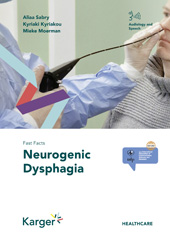Fast Facts : Neurogenic Dysphagia
140 p.
Dysphagia refers to any difficulty or problem with deglutition or bolus movement from the time the bolus is placed in the mouth until the time it enters the stomach. It affects around 16 million individuals in the USA and over 40 million individuals in Europe. Evaluation of dysphagia by a phoniatrician/speech-language pathologist (SLP) may consist of a clinical swallow evaluation and an instrumental assessment, such as a videofluoroscopic swallow study (VFSS) and fiberoptic endoscopic valuation of swallow (FEES). This resource is designed to benefit a broad audience, including phoniatricians, SLPs, trainee SLPs, physicians, nurses, dietitians, and occupational and physical therapists who work with populations who have dysphagia, as well as researchers in the field of swallowing disorders. Table of Contents: - Definition, etiology, epidemiology, symptoms and consequences - Normal swallowing and pathophysiology of dysphagia - Screening and clinical swallowing examination - Instrumental assessment - M
anagement - Recent advances and future directions [Publisher's text].
Special access authorizations may apply; please contact us for further information.
-
Información
ISBN: 9783318072167
MATERIAS


